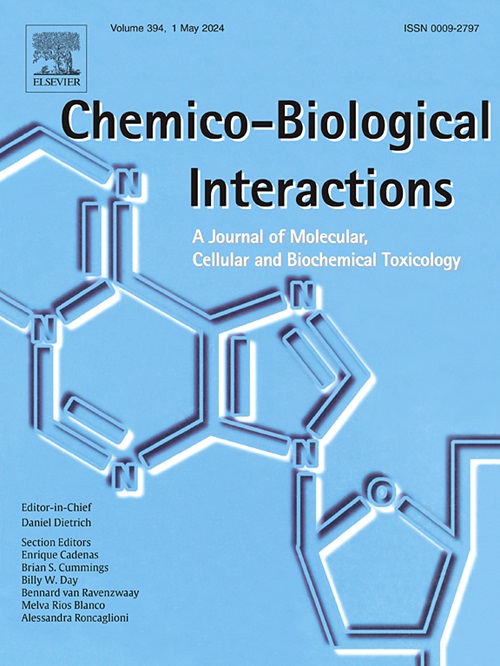ADME profile of AP-238 - opioid designer drug (CAS: 140924-11-4): first application of multi-in silico approach methodology for comprehensive prediction of ADME profile (absorption, distribution, metabolism and excretion) important for clinical toxicology and forensic purposes
IF 4.7
2区 医学
Q1 BIOCHEMISTRY & MOLECULAR BIOLOGY
引用次数: 0
Abstract
AP-238 is a recently emerged opioid designer drug from the cinnamylpiperazine class, raising increasing concern in forensic and clinical toxicology due to its potential for abuse and limited ADME (absorption, distribution, metabolism, and excretion) profile. This study presents the first comprehensive prediction of the ADME parameters for AP-238 using a multi-in silico approach. Multiple in silico methods (SwissADME, ACD/Percepta, pkCSM, ADMETlab 3.0, ADMET Predictor 12.0, Simulation Plus, XenoSite, and DruMAP) were employed to estimate key ADME parameters. Results indicate high gastrointestinal absorption and blood-brain barrier permeability, suggesting strong psychoactive potential. AP-238 exhibits pH-dependent solubility and interacts variably with P-glycoprotein, which may affect its systemic and central nervous system exposure. Distribution modeling revealed moderate to extensive tissue penetration and significant plasma protein binding. Metabolic simulations identified 11 primary metabolites and involvement of major CYP isoforms (including CYP2B6, CYP2C19, CYP2D6, CYP3A4). Excretion predictions suggest a rapid elimination primarily via hepatic routes. This study provides critical pharmacokinetic insight into AP-238, supporting its early toxicological assessment and prioritization for further investigation. The applied in silico strategy demonstrates a rapid, ethical alternative to traditional ADME testing, particularly valuable in the context of novel synthetic opioids.

AP-238--阿片类特制药物(化学文摘社编号:140924-11-4)的 ADME 特征:首次应用多元硅学方法全面预测对临床毒理学和法医学具有重要意义的 ADME 特征(吸收、分布、代谢和排泄)。
AP-238是最近出现的肉桂基哌嗪类阿片类设计药物,由于其潜在的滥用和有限的ADME(吸收、分布、代谢和排泄)特征,在法医和临床毒理学中引起了越来越多的关注。本研究首次采用多芯片方法对AP-238的ADME参数进行了综合预测。采用多种计算机方法(SwissADME、ACD/Percepta、pkCSM、ADMETlab 3.0、ADMET Predictor 12.0、Simulation Plus、XenoSite和DruMAP)来估计ADME的关键参数。结果表明,胃肠道吸收和血脑屏障通透性高,提示精神活动电位强。AP-238表现出ph依赖性溶解度,并与p -糖蛋白发生不同的相互作用,这可能影响其全身和中枢神经系统暴露。分布模型显示中度至广泛的组织渗透和显著的血浆蛋白结合。代谢模拟鉴定出11种初级代谢物和主要CYP亚型(包括CYP2B6、CYP2C19、CYP2D6、CYP3A4)的参与。排泄预测表明主要通过肝脏途径快速清除。这项研究为AP-238提供了关键的药代动力学见解,支持其早期毒理学评估和进一步研究的优先顺序。硅应用策略证明了传统ADME测试的快速,道德替代方案,在新型合成阿片类药物的背景下特别有价值。
本文章由计算机程序翻译,如有差异,请以英文原文为准。
求助全文
约1分钟内获得全文
求助全文
来源期刊
CiteScore
7.70
自引率
3.90%
发文量
410
审稿时长
36 days
期刊介绍:
Chemico-Biological Interactions publishes research reports and review articles that examine the molecular, cellular, and/or biochemical basis of toxicologically relevant outcomes. Special emphasis is placed on toxicological mechanisms associated with interactions between chemicals and biological systems. Outcomes may include all traditional endpoints caused by synthetic or naturally occurring chemicals, both in vivo and in vitro. Endpoints of interest include, but are not limited to carcinogenesis, mutagenesis, respiratory toxicology, neurotoxicology, reproductive and developmental toxicology, and immunotoxicology.

 求助内容:
求助内容: 应助结果提醒方式:
应助结果提醒方式:


